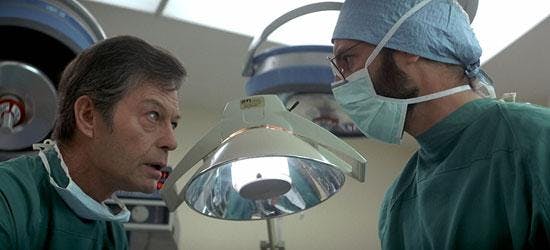Published Jun 2, 2014
TREKNOSIS: Making Dr. McCoy's Magic Pills Real
TREKNOSIS: Making Dr. McCoy's Magic Pills Real

When was the last time you gave yourself a paper cut? Have you ever looked at the scar it left behind and wondered why that's the limit of our healing abilities? Suffer a small cut and you can more or less grow new skin back to seal it up, but the new skin won't match what you had. Suffer something worse, like the loss of a limb, and you won't grow a new one. You can't even grow a new finger, much less an organ like an eyeball or a lung. Yet, there are lizards that can grow new tails – what gives? Are we forever doomed to never be able to truly heal ourselves? Is regeneration just not on the menu for us as humans?
No worries. What nature doesn't provide, we'll achieve through science. The Gladstone Institutes have reported a breakthrough in the development of a technique that allows scientists to transform skin cells into heart muscle cells. It doesn't sound like much, but it's the first step down a road that could take us to seemingly miraculous new regenerative therapies and out of what Dr. Leonard McCoy once called “the Dark Ages” during a trip to the good old 1980s in a borrowed Klingon Bird-of-Prey.

First things first, though: why is this discovery such a big deal? Let's say you've had a heart attack because an artery feeding blood to some part of your heart got blocked up. Starved for oxygen, the muscle cells in that zone of the heart died, putting a crater in the muscle tissue, and you in the hospital. Right now, there's not a lot that can be done to help you out. Sure, the artery can be unblocked and eventually your heart will heal, but it won't be the same. The scar tissue that forms over the crater won't contract and beat like true heart muscle. All the marks on your skin from past cuts and abrasions testify to scar tissue's just-good-enough policy of sealing up wounds and not doing much else. Having scar tissue on your heart instead of true heart muscle affects how much blood you can pump through your body, which in turn may affect your quality of life, depending upon how active you are.
But the Gladstone finding could one day lead to a new kind of heart attack recovery. Someday, doctors might be able to just slap an ordinary skin graft onto the damaged area, apply some as-yet-unknown new therapy, and transform the graft into healthy, brand new, beating heart tissue. Problem solved!
The regenerative therapy road doesn't stop there, either. Walk down it far enough, and we might find ourselves in a world where doctors can literally regenerate an entire nonfunctional, or even missing organ -- without lifting a scalpel. Yesterday, that would have sounded like some goofball combination of incredible and impossible. To Dr. McCoy, that's Tuesday. Check out the good doctor's miracle cure from Star Trek IV: The Voyage Home. When McCoy asks an old woman, “What’s the matter with you?” she replies, “Kidney, dialysis.” McCoy reacts in horror and gives her a pill. Moments later, she’s being wheeled around the hospital, shouting, “Doctor gave me a pill, and I grew a new kidney!”

Seem crazy? Consider this – right now, the only way scientists can reprogram a cell is to use a combination of chemical factors and genetic manipulation. It isn't easy. What's so interesting about the Gladstone scientists' discovery is that it seems to hint that cellular reprogramming might be possible with chemicals alone, which points the way toward possibly developing an entirely pharmaceutical solution. Imagine a day when recovering heart attack sufferers can take a drug cocktail that causes new heart muscle to grow over the injured parts instead of scar tissue. Or maybe just one “magic” pill.
But why stop at new heart tissue? “The doctor gave me a pill, and I grew a new kidney!” could one day end up being more science reality than science fiction. Two of the biggest hassles in organ transplants today are rejection by the host and just being able to find the right organ for the right person from the right donor in the first place. How much easier would it be to just grow one of your own? Numerous companies are currently working on organogenesis to address a shortage of available, transplantable organs, and the UCLA Dream Fund is currently funding the development of an organogenesis XPRIZE to generate functioning, compatible organs (lung, kidney, heart, liver, pancreas) from a patient’s own cells. If any of this research pans out, a simple pill that'll sprout you a new, completely functional kidney doesn't seem so crazy after all.
source: Gladstone Institutes press release
Jon Sung is a contributing writer for XPRIZE and copywriting gun-for-hire to startups and ventures all over the San Francisco Bay area. When notwrangling wordsfor business or pleasure, he serves as the first officer of the USS Loma Prieta, the hardest-partying Star Trek fan club in San Francisco.
XPRIZE is an innovation engine. We design and operate prize competitions to address global crises and market failures, and incentivize teams around the world to solve them. Currently, we are operating numerous prizes including the $30M Google Lunar XPRIZE, challenging privately funded teams to successfully land a robot on the Moon’s surface, and the $10M Qualcomm Tricorder XPRIZE, challenging teams around the world to create a portable, wireless, Star Trek-inspired medical device that allows you to monitor your health and medical conditions anywhere, anytime. The result? Radical innovation that will help us all live long and prosper.
Sign up today to join our mission, be a part of our campaign and win collectibles at:tricorderfederation.org




